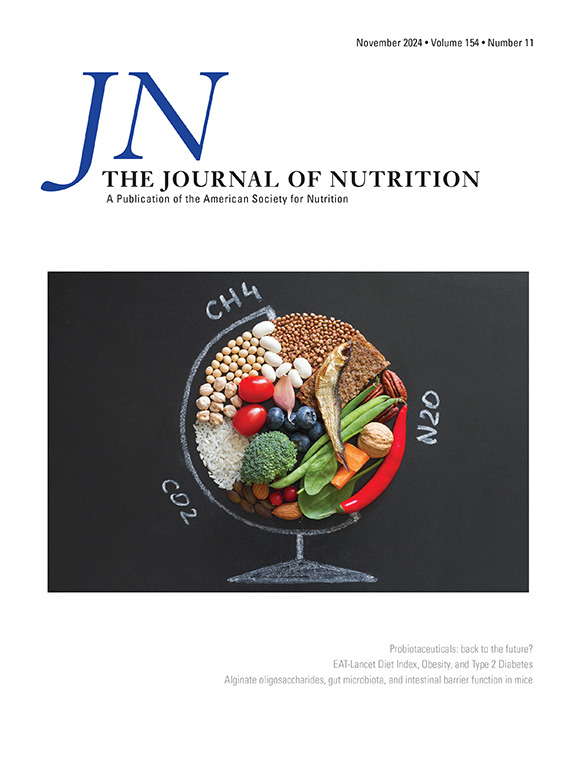Effect of 3 Different Daily Protein Intakes in a 2-Meal Eating Pattern on Protein Turnover in Middle Age and Older Adults: A Randomized Controlled Trial
IF 3.7
3区 医学
Q2 NUTRITION & DIETETICS
引用次数: 0
Abstract
Background
Reduced meal frequency patterns have become popular for weight loss, maintenance, and improving cardiometabolic health. The extended fasting windows with these dietary patterns could lead to greater protein breakdown, which is a concern for middle-aged and older adults who may need higher protein intakes to maintain or increase net protein balance.
Objectives
This study aimed to quantify muscle and whole-body protein kinetic responses to 3 different daily protein intakes within a 2-meal eating pattern.
Methods
Thirty participants (age: 61 ± 6 y, BMI: 26.5 ± 4.8 kg/m2) participated in this 24-h metabolic study using oral stable isotope tracer techniques and were randomized to 1 of 3 protein intakes: 1) recommended dietary allowance (RDA): 0.8 g/kg/d; 2) habitual United States intake: 1.1 g/kg/d; or 3) ≈2RDA: 1.5 g/kg/d distributed across 2 meals, consumed within a 9-h window.
Results
Whole-body net protein balance was significantly higher for 1.5 g/kg/d compared with 0.8 g/kg/d [mean difference: 0.55 g/kg; lean body mass (LBM)/d; 95% confidence interval (CI): 0.17, 0.93 g/kg LBM/d; P = 0.004] and 1.1 g/kg/d (mean difference: 0.6 g/kg LBM/d; 95%CI: 0.23, 0.97 g/kg LBM/d; P = 0.001), with no difference between 0.8 and 1.1 g/kg/d (mean difference: 0.05 g/kg LBM/d; 95%CI: −0.31, 0.40 g/kg LBM/d; P = 0.936). Muscle protein synthesis was not significantly different between any groups (P = 0.388).
Conclusion
s: Within a 2-meal eating pattern, a protein intake of 1.5 g/kg/d led to a more positive whole-body net protein balance than intakes of 0.8 and 1.1 g/kg/d in middle-aged and older adults.
This trial was registered at clinicaltrials.gov as NCT04830514.
一项随机对照试验:两餐模式下每日三种不同蛋白质摄入量对中老年人蛋白质周转的影响
背景:减少进餐频率模式已成为减肥、维持体重和改善心脏代谢健康的流行方式。这些饮食模式下延长的禁食窗口期可能会导致更多的蛋白质分解,这是中年和老年人可能需要更高的蛋白质摄入量来维持或增加净蛋白质平衡的一个问题。目的:本研究的目的是量化肌肉和全身蛋白质对两餐进食模式下三种不同的每日蛋白质摄入量的动力学反应。方法:30名参与者(年龄:61±6岁,体重指数:26.5±4.8 kg/m2)通过口服稳定同位素示踪技术参与了这项24小时代谢研究,并随机分为三种蛋白质摄入量之一:1)推荐膳食摄取量(RDA): 0.8 g/kg/天;2)美国习惯摄入量:1.1g/kg/天;或3)≈2RDA: 1.5g/kg/天,分两餐,在9小时内消耗。结果:1.5g/kg/d的全鱼净蛋白质平衡显著高于0.8 g/kg/d(平均差异:0.55 g/kg LBM/d;95%置信区间:0.17 ~ 0.93 g/kg LBM/d;p=0.004)和1.1g/kg/d(平均差值:0.6 g/kg LBM/d;95%置信区间:0.23 ~ 0.97 g/kg LBM/d;p=0.001), 0.8和1.1g/kg/d之间无差异(平均差异:0.05 g/kg LBM/d;95%置信区间:-0.31 ~ 0.40 g/kg LBM/d;P = 0.936)。各组间肌肉蛋白质合成差异不显著(p = 0.388)。结论:在两餐进食模式下,与0.8和1.1 g/kg/天的蛋白质摄入量相比,中老年人每天摄入1.5 g/kg/天的蛋白质会带来更积极的全身净蛋白质平衡。试验注册:ClinicalTrials.gov标识符:NCT04830514。
本文章由计算机程序翻译,如有差异,请以英文原文为准。
求助全文
约1分钟内获得全文
求助全文
来源期刊

Journal of Nutrition
医学-营养学
CiteScore
7.60
自引率
4.80%
发文量
260
审稿时长
39 days
期刊介绍:
The Journal of Nutrition (JN/J Nutr) publishes peer-reviewed original research papers covering all aspects of experimental nutrition in humans and other animal species; special articles such as reviews and biographies of prominent nutrition scientists; and issues, opinions, and commentaries on controversial issues in nutrition. Supplements are frequently published to provide extended discussion of topics of special interest.
 求助内容:
求助内容: 应助结果提醒方式:
应助结果提醒方式:


